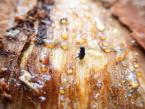For a homeowner, especially one with a fondness for gardening and landscaping, winter is the season for making plans and thinking about the possibilities of the coming year. As you contemplate your yard this winter, here’s a question to ask yourself: “How much lawn do I really need?”
Modern patterns of homebuilding and landscaping tend to make sod-grass lawn the default use for any available space. For much of the new construction on the Vineyard, the entire lot is stripped of its native vegetation and nonnative grasses are hydroseeded in or placed down in the form of sod. To be sure, this makes a property look like what most of America thinks is normal. But expanses of lawn come with a stiff price in ecological impact, as well as maintenance costs for the homeowner.
Very little of our wildlife draws any significant benefit from a lawn. And most of the species that do use lawns are either very common (like the American robin, which is a nice bird but one that needs no conservation) or undesirable (like the nonnative Japanese beetle, which spends its immature months as grubs in the root system of sod lawns). Composed of nonnative grasses that our native wildlife can’t make use of, lawns come pretty close to being ecological deserts: expanse that large animals won’t use and small animals don’t like to cross.
Meanwhile, a well-maintained lawn makes endless demands for maintenance: mowing every week or two, fertilizer application to make up for lean Vineyard soils, watering to counteract summertime drought, weeding or herbicide application to keep weeds under control, and endless war against Japanese beetles if they get established. The process is costly, time-consuming, or both. And to the extent that application of chemicals is involved, lawn maintenance can have harmful effects on the Vineyard’s ground and surface waters.
But how much do you use the resulting lawn? In our experience, for many homeowners, the answer is, “Not much.” If you have kids, they may play there some; your dog, if you’ve got one, may frolic there a bit. But for many property owners on the Vineyard, a green sod lawn is an expensive waste of space, doing not much more than looking conventional.
If this sounds familiar, consider changing what you grow. The change can be as dramatic as converting your entire lawn into a native meadow, with local grasses and wildflowers; or you can make changes more gradually, planting in native flowers, grasses, or shrubs in patches or along edges. Even the very simple measure of setting aside part of your lawn to mow only once or twice a year produces useful wildlife habitat; beneficial insects will take advantage of the more substantial structure of uncut grass to hide and reproduce.
If you truly need some lawn for the kids to play on, or to work on your putting, or simply because you love the look of a lawn, that’s fine. But we recommend making the decision about how much lawn to have a deliberate one. Don’t just assume that lawn needs to dominate your property. The Vineyard Habitat Network can offer a host of ideas that can save you time and money, reduce the negative impacts your yard may be having on the Island’s ecology, and help you establish a productive piece of habitat that will benefit wildlife while bringing natural beauty and interest in close to home.







Comments
Comment policy »